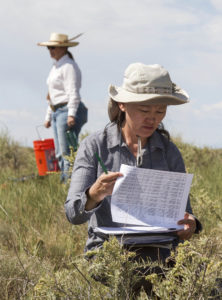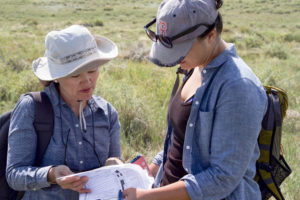When she was young, Chantsallkham Jamsranjav spent summers herding with her grandparents throughout Mongolia’s extensive rangelands. They acted as her mentors, teaching her how the landscape changed between sunrise and sunset every day.

“My grandfather used to say that if the wind comes from the southeast that meant rain,” Jamsranjav remembered. “He was right, and I always wanted to know why.”
Now a postdoctoral researcher at Colorado State University studying rangeland ecology, Jamsranjav recently received a highly competitive International Fellowship from the American Association of University Women. Jamsranjav was one of only 250 women worldwide to receive AAUW funding for research or community work in the 2017-2018 academic year..
Academic inspiration from her homeland
Jamsranjav completed her doctorate in the Department of Forest and Rangeland Stewardship in 2015, and chose CSU to conclude her rangeland ecology training. “CSU is the right place to study rangelands,” Jamsranjav said.
Jamsranjav’s postdoctoral research is centered on explaining how Mongolian herders observe change in their rangelands. Her methods require analyses from qualitative interview data, quantitative ecological data and remote sensing data from satellite imagery. This trifold approach is unique to research done in Mongolia, and Jamsranjav hopes her conclusions will provide the comprehensive evidence policymakers need to affect better rangeland practices across the country.
This desire to help her fellow Mongolians initially motivated Jamsranjav to take her studies further. She became interested in the science behind rangeland ecology and management while working for a non-governmental organization in her native homeland over a decade ago. As she promoted community based conservation, herders asked ecological questions. “I wanted to gain the expertise needed to answer those questions,” she said.
In 2008, a fortunate meeting with CSU Associate Professor Maria Fernandez-Gimenez in Mongolia provided Jamsranjav with serendipitous direction. Fernandez-Gimenez has done extensive ecological and social research on rangelands and communities in Mongolia and has watched Jamsranjav develop into a talented scientist.
“Chantsa has a tenacious intellectual curiosity and a passion for science that is very valuable to this discipline,” Fernandez-Gimenez said. “She is also committed to bringing this knowledge back to Mongolia and sharing it.”
Dedicated mentorship
The hundred-year-old annual AAUW International Fellowship program has promoted equity and education for women and girls around the world for generations. Recipients are selected based on academic achievement and a demonstrated commitment to improving their communities.

Recipients also exemplify mentorship to women and girls in their field. Jamsranjav’s personal impact is reaching a new generation of Mongolian students interested in rangeland science and management and she is leading by example. “Education is becoming more hands-on and student-focused in Mongolia,” she said. “I show students that talking and working problems out as a team is the best way to answer difficult questions and broaden your own horizons.”
Now with her scientific background, Jamsranjav knows the answer to her childhood question; Southeastern winds drive rain from the Asian monsoon into Mongolia during the summer. This example exemplifies her work’s connection between the knowledge herders like her grandfather have of the land and science.
Finding the answer to this question was just the beginning. She now asks questions that can make scientific conclusions and recommendations at the national level in Mongolia. When Jamsranjav returns to Mongolia she is confident that she will go beyond answering herders’ ecological questions and inspire better rangeland management through public discourse and action.